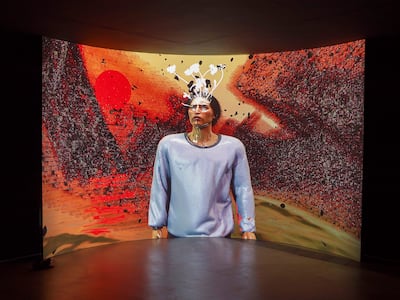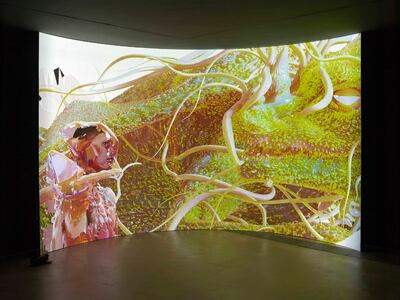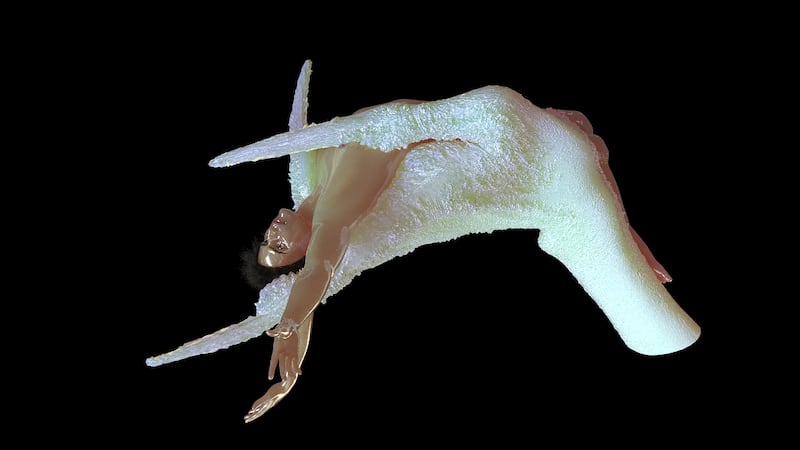The latest video by Bassam Al-Sabah, I Am Error (2021), on view at the independent art space Gasworks in London, until September 19, is deliberately unreal. A male character, vaguely resembling a video game avatar, floats in a glossy sea that has the perturbing consistency of sticky jelly and the transparent colour of water viewed from below. He tumbles and twists about, but can’t seem to extricate himself from the viscous mess.
Like all of Al-Sabah’s work so far, I Am Error is steeped in CGI, and its video game-like avatars play out feats beyond superhuman strength. The Iraqi-born artist works with CGI “like a painter”, he says, moving scenarios of combat and struggle towards languorous, disturbing stories that luxuriate in odd textures and surreal transformations, with searching, almost lost characters.

It demonstrates a fascination with the theme of violence, which seems to have two sources for the artist, who lives in Belfast. On the one hand, it comes from an early love for video games, which he played in Baghdad, and on the other, his family’s experience during the Second Gulf War.
In 2004, when Al-Sabah was 9, he, his mother and sister fled the Iraqi capital, moving to the Republic of Ireland, where his father had been working. They left their house, and his grandmother, behind.
These details appear in one of Al-Sabah’s early works, the video Fenced Within the Silent Cold Walls (2018). In it, he imagines his grandmother walking through their old house, emptied of its inhabitants, but brought to life again by Al-Sabah’s rendering of its thick, grey walls, floating stairs and upstairs majlis. A tangle of thick tentacles reach out of the radio and TV, in black and army camouflage, filling the house. Little by little, the scene is pocked apart by glitchy, floating orbs, as the sound of bombing rumbles outside. In the final sequence, his grandmother describes how she burnt the family photographs to forget her once happy life.
The video is devastating – and also became a turning point for Al-Sabah. “When the show [at the Lab Gallery in Dublin] was happening, a few people cried,” he recalls. “And something happened to me that I hadn’t expected emotionally. I didn’t want my experience to be so there. Now, I want to find a space that feels not so personal to me, so that somebody else can think about other forms of trauma or other forms of violence that aren't so specific to my experience.”

While still remaining in the lexicon of CGI and video games, he began searching for universal resonances. In a series of subsequent videos, such as Dissolving Beyond the Worm Moon (2019), he unpacked the amped-up masculinity that video game avatars embody, with their beefed-up muscles and warlike stance, in contrast to the real trauma that such bodies would endure. Other works consider the moral hazard of video games, where rampant violence occurs, but remains on screen.
Repercussions, he notes, are not a given in video games – and nor are they in real life..
Violence persists in Al-Sabah's work, but it is febrile, malleable: a character chained down is as likely to transform into a yellowy crystal as to meet a gory end. Conflict is more gestured at than depicted, in the image of a bunker on a desolate hill, for example, or the muscles of a soldiering avatar. But the stories are also open-ended, and aesthetically mesmerising. Fine renderings of flowers and plant fronds dot the videos like unexpected oases, and smooth, liquid effects offer the constant possibility of change.
Growing up in sanctions-era Iraq, video games provided Al-Sabah with an introduction to pop culture, in contrast to the TV shows that captivated older generations. Because he couldn’t understand English, he gravitated towards games with rich visual languages, such as Metroid, an early Nintendo game that was developed in the late 1980s.

The end sequence in Metroid’s second game stood out for him in particular. The story’s protagonist, a bounty hunter, finds the last baby metroid and looks after it. The infant thinks the character is its mother, even though she is the one who has destroyed the metroid world.
Years later, he watched an interview with one of the creators of the game. “He said he wanted the ending sequence to force you to think about the fact that you've killed an entire race,” Al-Sabah recalls. “It’s told in a very quiet, really wonderful way. The game has been very impactful on me. It’s made me think about what power means.”
Though his videos stage the idea of someone falling into a vortex of CGI, the exhibitions have become a place for him to question how CGI can live in reality. He supplements his videos with 3D-rendered sculptures, a technique he learnt while working an odd-job at a 3D printer centre. Like a sculptor with a chisel, he works with software whereby an object is cut away from a block of foam rather than being built up through layers.
His goal, he says, is to find the place where his artwork looks realistic – but also somehow wrong. The work skirts close to the “uncanny valley”, or the moment in which CGI-rendered characters appear so realistic that they become eerie, almost repugnant. But his heart appears to lie with the potential of glitches and error.
“I like the idea of going to 95 per cent real, but then pulling back on like the last 5 per cent, where you see some of the kind of strange effects that happen when things go wrong in that software,” he says. When things are too perfect, "they feel a little bit removed from humanity".
I Am Error is on view at Gasworks in London until Sunday, September 19. More information is available at gasworks.org.uk






